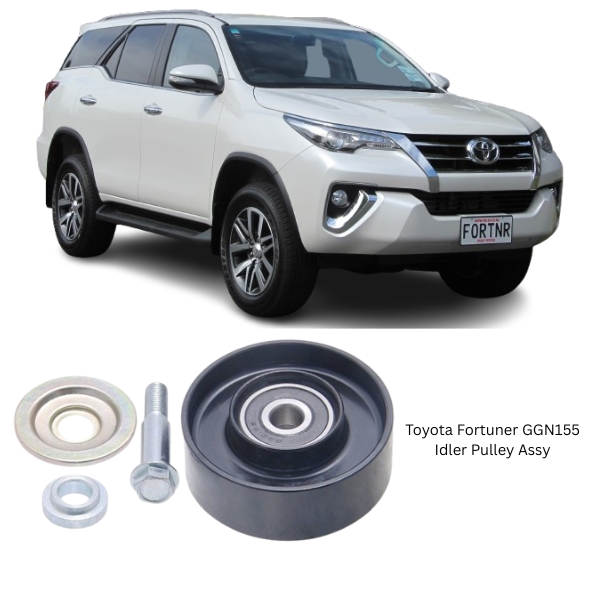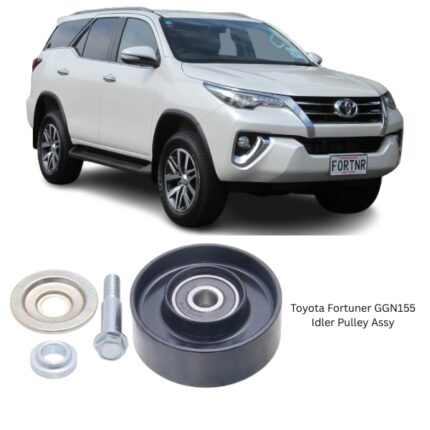Get Toyota Fortuner GGN155 Idler Pulley Assy 0188-KUN25 in Kenya
The idler pulley assembly is a crucial component in a vehicle’s engine system that supports and guides the drive belts, ensuring they operate smoothly and efficiently. The assembly consists of an idler pulley, a bracket, and sometimes additional hardware to secure it in place. Though the idler pulley does not drive any accessories directly, its role is essential for maintaining the correct tension and routing of belts.
This guide provides a detailed explanation of the idler pulley assembly, including its structure, function, benefits, common issues, maintenance, and replacement. We will also explore how the idler pulley interacts with other components in the engine system to ensure optimal performance.
1. Structure of the Idler Pulley Assembly
The idler pulley assembly typically consists of the following components:
- Idler Pulley: The idler pulley is a wheel with a smooth or grooved surface. It is designed to route the drive belt, helping to maintain tension and guide the belt as it travels around various engine components, such as the alternator, air conditioning compressor, water pump, and power steering pump.
- Bracket: The idler pulley is mounted on a bracket, which attaches to the engine block. The bracket holds the pulley in place and ensures it remains aligned with the belt.
- Bolt and Spacer: In some designs, a bolt passes through the center of the pulley and secures it to the bracket. A spacer or washer may be used to provide proper clearance and prevent contact between the pulley and the bracket.
- Bearing: Inside the pulley, there is typically a bearing that allows the pulley to rotate freely on the bracket. The bearing reduces friction and wear, enabling the pulley to spin smoothly as the belt moves over it.
2. Function of the Idler Pulley Assembly
The idler pulley plays a vital role in ensuring the drive belt operates effectively. Here’s how the assembly functions within the engine system:
- Guides the Belt: The idler pulley routes the serpentine belt (or drive belt) around various engine components. By providing a smooth surface for the belt to travel over, it helps maintain proper alignment and prevents the belt from slipping off or twisting.
- Maintains Belt Tension: Though the idler pulley itself does not control tension (that is the role of the tensioner pulley), it works in tandem with other pulleys to keep the belt taut. Proper tension is essential for transferring power efficiently to the engine accessories like the alternator, water pump, and air conditioning compressor.
- Reduces Belt Wear: The idler pulley assembly ensures that the belt runs smoothly over the other pulleys without excessive friction. By guiding the belt, it prevents unnecessary wear and tear, extending the life of the belt and reducing the need for frequent replacements.
3. Types of Idler Pulleys
Depending on the vehicle and engine configuration, there are different types of idler pulleys used:
- Smooth Idler Pulley: A smooth pulley is designed to guide the flat side of the belt. It provides a friction-free surface for the belt to travel over, reducing wear on both the pulley and the belt.
- Grooved Idler Pulley: A grooved pulley is used with the ribbed side of the serpentine belt. The grooves help maintain the belt’s alignment and prevent it from slipping off the pulley.
- Fixed vs. Adjustable Idler Pulley: Some idler pulleys are fixed in place, while others are adjustable. An adjustable idler pulley can be moved to fine-tune the tension on the belt, ensuring proper operation of the drive belt system.
4. Importance of the Idler Pulley Assembly
While the idler pulley may seem like a simple component, it serves several important functions that contribute to the overall performance and longevity of the engine’s accessory drive system:
- Ensures Proper Belt Operation: Without a functioning idler pulley, the serpentine belt would not be able to maintain proper alignment or tension, leading to slippage, excessive wear, and potential belt failure. The idler pulley ensures the belt runs smoothly over all the other pulleys.
- Reduces Engine Load: By reducing friction and wear on the belt, the idler pulley assembly helps minimize the load on the engine. This allows the engine to operate more efficiently, improving fuel economy and reducing wear on other components.
- Prevents Belt Misalignment: A misaligned belt can cause significant damage to the engine’s accessories, such as the alternator or water pump. The idler pulley keeps the belt properly aligned, preventing damage to these critical components.
5. Signs of a Faulty Idler Pulley
Over time, the idler pulley may wear out, develop issues, or fail entirely. Here are some common signs that indicate a problem with the idler pulley assembly:
- Squealing or Grinding Noise: One of the most noticeable symptoms of a worn-out idler pulley is a high-pitched squealing or grinding noise coming from the engine. This noise often occurs when the bearings inside the pulley wear out, causing friction between the pulley and the belt.
- Belt Slippage: If the idler pulley fails to keep the belt properly aligned or if the pulley is damaged, the belt may begin to slip. This can result in poor performance of the engine accessories, such as reduced charging capacity from the alternator or weak power steering.
- Visible Wear or Damage: A visual inspection of the idler pulley may reveal cracks, chips, or excessive wear on the pulley’s surface. Additionally, if the bearing is damaged, the pulley may wobble or appear misaligned.
- Belt Vibration: A failing idler pulley can cause the serpentine belt to vibrate excessively, leading to uneven wear or eventual belt failure.
- Engine Overheating: Since the serpentine belt drives the water pump, a failing idler pulley can cause the belt to slip or stop turning the pump. This can result in the engine overheating, which can lead to more severe damage if not addressed.
6. Maintenance and Replacement
Regular maintenance of the idler pulley assembly is important for keeping the engine’s drive belt system in optimal condition. Here are some tips for maintaining and replacing the idler pulley assembly:
- Regular Inspections: During routine maintenance, inspect the idler pulley for any signs of wear, such as cracks, chips, or excessive movement. Also, listen for any unusual noises coming from the pulley area when the engine is running.
- Check Belt Condition: Since the idler pulley works closely with the drive belt, it’s essential to check the belt’s condition regularly. Look for cracks, fraying, or glazing on the belt’s surface, as these are signs that the belt may need to be replaced.
- Lubricate Bearings (if applicable): Some idler pulleys have sealed bearings that do not require lubrication, while others may need periodic lubrication to ensure smooth operation. Follow the manufacturer’s recommendations for maintenance.
- Replace When Necessary: If the idler pulley is showing signs of wear or if the bearing is making noise, it’s important to replace the assembly promptly. Ignoring a failing idler pulley can lead to belt failure, which can cause damage to other engine components.
- Use Quality Parts: When replacing the idler pulley assembly, use high-quality, OEM (Original Equipment Manufacturer) or aftermarket parts. Quality components ensure long-lasting performance and prevent premature failure.
7. Idler Pulley Assembly Replacement Procedure
Replacing an idler pulley assembly is a relatively straightforward process that can be done by a professional mechanic or a skilled DIYer. Here’s a general guide for replacing an idler pulley assembly:
- Prepare the Vehicle: Park the vehicle on a flat surface and engage the parking brake. Disconnect the battery to prevent any electrical shorts while working on the engine.
- Release Belt Tension: Use a wrench or ratchet to release tension on the serpentine belt by turning the tensioner pulley. Once the tension is released, carefully remove the belt from the idler pulley.
- Remove the Old Pulley: Using the appropriate socket, remove the bolt securing the idler pulley to the bracket. Carefully slide the pulley off the bracket and inspect the surrounding area for any damage or debris.
- Install the New Pulley: Position the new idler pulley on the bracket and secure it with the bolt. Ensure that the pulley is properly aligned and spins freely.
- Reinstall the Belt: Carefully route the serpentine belt back over the pulleys, ensuring that it is properly aligned with all the grooves. Use the tensioner pulley to apply the correct tension to the belt.
- Test the Engine: Reconnect the battery and start the engine. Listen for any unusual noises and check that the belt is running smoothly over the idler pulley.
8. Conclusion
The idler pulley assembly plays a crucial role in ensuring the smooth operation of a vehicle’s drive belt system. By guiding the serpentine belt and maintaining proper alignment, the idler pulley reduces wear on the belt and engine accessories, contributing to overall engine performance and efficiency.
Regular inspections, maintenance, and timely replacement of the idler pulley assembly are essential for preventing more serious issues, such as belt failure or engine damage. By understanding the functions, benefits, and signs of wear, drivers can keep their vehicle’s idler pulley in top condition, ensuring long-lasting reliability and optimal performance.
Follow us on Facebook for more parts.





Reviews
Clear filtersThere are no reviews yet.